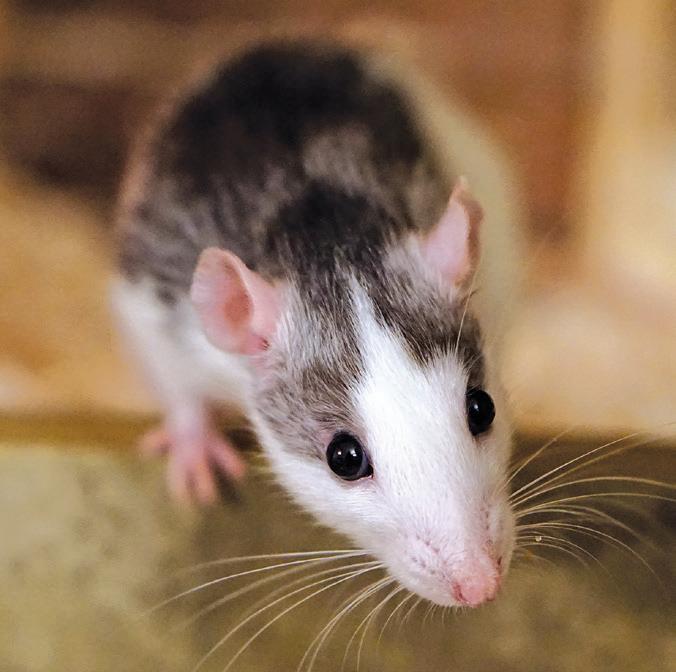
6 minute read
pets
Aww Rats! Aww Rats!
When my youngest son was four, a friend asked if we could take care of their rats while they went on vacation. Micah was very excited, so two rats, Whiskers and Squeakers, came to stay with us for a week. Not having spent much time with rats before, I wasn’t sure what to expect. But they were really fun! They would run around in Micah’s room, sit on his shoulder, and eat pretty much anything he gave them. We were all sad when the rats went back home, so for Micah’s fifth birthday, we added another pet to our household, Jimmy Juper Explorer Rat.
Advertisement
I know what most of you are thinking: Eww, a rat. That tail is so gross! Don’t they bite? They are so dirty. Well, I’m hoping to convince you that rats actually make very good pets.
The first thing to know is that pet rats are not the big, brown Norway rat (aka sewer rat) that people generally picture. It’s thought that albino Norway rats were captured in the wild because they were so unique. These albinos were then bred and raised, eventually becoming the typical lab rat seen in research laboratories today. Whiskers and Squeakers were actually retired lab rats from a psychology project!
So why consider a rat as a pet? First, they have a personality similar to a dog. They enjoy being around people, they come when they are called, they love to get people food, and they can learn to do tricks. Unlike a dog, you don’t need to take them out for daily walks, and they don’t need to be brushed or go to a groomer. You can bathe them, but like many dogs, they don’t appreciate it that much.
They’re independent, like cats, but are much less likely to aggravate anyone’s allergies. They clean themselves frequently. You can leave them for a few days without worrying too much about them as long as they have adequate food and water.
Rats also come in different styles, sizes, and colors. Jimmy Juper was white with brown patches and brown eyes, while Whiskers and Squeakers were larger, all-white rats with pink eyes. There are Rex rats, who have curly hair and whiskers, and Manx rats, who don’t have a tail (so now you don’t have that excuse). Dumbo rats have large ears that make them look like the cartoon elephant. There are spotted varieties called Dalmatians and grey-toned ones called Siamese. There are also hairless rats, but if you don’t like that scaly tail, you probably want to start with one that has fur.
If you’ve not had a pet before, rats are a good way to ease into pet ownership. They aren’t very expensive and may even be free. Whiskers and Squeakers were adopted from a psychology laboratory after they were used for research projects. The humane society has rats up for adoption too. They do require a
by Lori Scarlett, DVM
sturdy metal cage, preferably powdercoated metal and a solid bottom. Rats are chewers, so no plastic sides. Jimmy Juper started out in a small cage, but as he got bigger, we bought him a larger cage with three levels and several ramps.
For their bedding, avoid cedar or pine chips, which contain oils that can be toxic to rats. Aspen chips or recycled paper pellets are ideal. Rats love to make little nests, so provide them with small cardboard boxes and paper tubes, paper towels, and small scraps of towels that they can use to line their nests. Although they aren’t potty trained per se, rats do tend to pick a few spots in the cage as their bathroom, which makes it easier to keep the cage clean each day. You will want to clean the entire cage out once every week or two.
Rats are social creatures; it’s best to get them as pairs of the same sex. Astoundingly, rats reach sexual maturity by about eight weeks of age! Gestation is about three weeks, and litter sizes range from 8 to 18 pups. If you’ve inadvertently gotten a male and female pair, you will quickly realize your mistake! Males do well together if they are introduced at a young age, but if one of the pair dies, it will be more difficult to introduce another rat later on. First-time rat owners may want to start with a pair of females. It’s possible to have your rats spayed and neutered, which will certainly prevent unwanted litters, and spaying by three months
Most rats are pretty healthy, but like indoor-only cats, they can develop diseases and get sick. Mammary tumors are quite common, particularly in older female rats, but males have a lot of mammary tissue and can develop these tumors too. About 90 percent of mammary tumors in rats are benign, but they can get very large and impact quality of life. These tumors can be surgically removed, and it’s best to have that done before the tumor gets too large.
Other rat diseases include a chronic respiratory illness caused by bacterial infection, which can be controlled with antibiotics. There is a coronavirus that infects rats and can cause upper respiratory signs, like sneezing and enlarged lymph nodes. Most rats recover and have good immunity to future infections.
Just like dogs and cats, rats can also be infested with fleas, lice, and mites. If your rat is scratching a lot, losing hair, or has scabs on their body, you should have it examined by a veterinarian. Other signs of illness include increased drinking, more urine produced, diarrhea, decreased appetite, and weight loss.
After we lost Jimmy Juper, we adopted two female rats from the humane society. Their cage ended up near the kitchen, and my husband greeted them each morning and gave them a small piece of banana. We allowed them to run around the room, during which the cats would watch them closely then run in the opposite direction when the rat came toward them! Supervision when the rats are out of their cage is a must, as they do like to chew computer cords.
With an average lifespan of one and a half to three years, rats were part of our home for about six years. By that time, Micah became less interested in playing with the rats, so after saying goodbye to our last rat, we dismantled the cage. If my time and space weren’t filled with dogs and cats, I would definitely get more rats. I hope you’ll consider them as a pet too! Lori Scarlett, DVM, is the owner and veterinarian at Four Lakes Veterinary Clinic. For more information, visit fourlakesvet.com.
Lori Scarlett, DVM & Charlie

Photograph by Brenda Eckhardt







Tadsen Photography
Drone/Aerial Imagery











